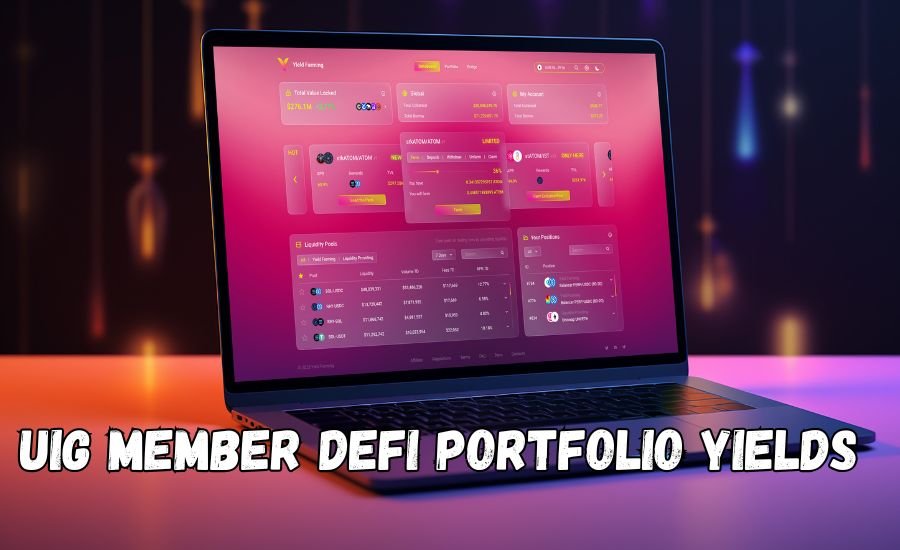UIG Member DeFi Portfolio Yields: How to Maximize Your Earnings

The world of decentralized finance (DeFi) has rapidly grown over the past few years. It’s no surprise that investors are increasingly drawn to the idea of getting high returns from digital assets without the need for a traditional bank or financial institution. One of the latest developments in the DeFi space is the concept of DeFi portfolios, and in particular, how UIG members can leverage these portfolios to maximize their yields. In this article, we’ll explore the concept of DeFi portfolio yields and how UIG members can take advantage of this growing trend.
What is DeFi and Why Should You Care?
DeFi, or decentralized finance, refers to financial services and products that are accessible on the blockchain, without the need for intermediaries like banks or brokerages. This means that anyone with an internet connection can access a wide range of financial services—such as lending, borrowing, and trading—without going through traditional financial institutions.
One of the most compelling reasons to care about DeFi is the opportunity for higher yields. Traditional banks offer relatively low returns on savings, but with DeFi, the potential for much higher returns is possible due to decentralized networks and liquidity pools. For UIG members, who are part of an exclusive community focusing on innovation and growth, entering the DeFi world with a smart portfolio strategy can lead to impressive returns.
What Are DeFi Portfolio Yields?
DeFi portfolio yields refer to the return on investments made through decentralized finance platforms. A portfolio in this context consists of various DeFi assets that generate yields through lending, staking, or liquidity provision. Instead of relying on a single investment, a DeFi portfolio involves diversifying across different platforms and assets to reduce risk while maximizing gains.
For example, one might hold various tokens, including stablecoins and altcoins, while participating in different DeFi protocols that offer attractive interest rates. A well-balanced DeFi portfolio might involve allocating capital to high-yield farming protocols, staking mechanisms, and lending pools.
Why UIG Members Should Focus on DeFi Portfolio Yields
As a UIG member, you have access to exclusive opportunities and insights that can help you grow your digital assets. One of the key reasons to focus on DeFi portfolio yields is the sheer potential for growth compared to traditional finance. While traditional portfolios often see modest returns, DeFi portfolios have the potential to achieve much higher yields due to the dynamic nature of decentralized networks.
Moreover, UIG members often have access to cutting-edge information and tools that can assist in maximizing returns. For those who are new to DeFi, the learning curve can seem steep, but with the right resources and support, UIG members can gain a significant advantage.
Types of DeFi Yields: An Overview
There are several ways to generate yields in the DeFi world, and understanding them can help you make informed decisions about how to structure your portfolio. Let’s explore the most common types:
- Yield Farming
Yield farming is one of the most popular ways to generate passive income in the DeFi space. It involves lending your crypto assets to liquidity pools in exchange for rewards. These pools, in turn, provide liquidity to decentralized exchanges, allowing for seamless trading. Yield farmers often earn returns in the form of the platform’s native token. - Staking
Staking involves locking up a specific amount of cryptocurrency to support the operations of a blockchain network. In return, stakers are rewarded with more cryptocurrency. This method can offer consistent returns with relatively low risk, depending on the asset being staked. - Lending and Borrowing
DeFi lending platforms allow you to lend your digital assets to borrowers in exchange for interest payments. These platforms use smart contracts to facilitate loans without the need for an intermediary. This can be a stable way to generate returns, especially when lending stablecoins, which are less volatile than other cryptocurrencies. - Liquidity Mining
Liquidity mining is similar to yield farming but focuses on providing liquidity to specific decentralized exchanges or platforms. In return for locking up funds in liquidity pools, users are rewarded with tokens. - Governance Tokens
Some DeFi platforms reward participants with governance tokens, which give them a say in the platform’s future direction. These tokens can also have value on the open market, offering another potential yield avenue.
Read Next: FINBUINES
Building a Strong DeFi Portfolio as a UIG Member
The key to building a strong DeFi portfolio is diversification. By spreading your investments across different platforms and assets, you can reduce risk while still taking advantage of high-yield opportunities. Here are some steps to consider when building your DeFi portfolio:
- Understand Your Risk Tolerance
Different DeFi projects carry different levels of risk. High-yield farming protocols may offer significant returns, but they also come with a higher risk of impermanent loss. On the other hand, staking stablecoins or lending platforms may provide lower returns but are generally considered safer. As a UIG member, assess your risk tolerance and plan your portfolio accordingly. - Research Projects Thoroughly
Not all DeFi projects are created equal. Before investing in a project, take the time to research its team, the technology behind it, and its market potential. UIG members can leverage exclusive insights and research to identify promising projects that are likely to deliver strong yields over time. - Stay Updated on Market Trends
The DeFi space is constantly evolving, with new protocols and opportunities emerging regularly. As a UIG member, staying updated on the latest trends and developments in the DeFi market is crucial. Subscribing to newsletters, participating in discussions, and using market analysis tools can help you stay ahead of the curve. - Allocate Capital Strategically
It’s important to allocate your capital wisely across different DeFi platforms. For example, you might want to allocate a portion of your funds to stablecoins for lending purposes while placing riskier assets in yield farming pools. By diversifying, you can protect your portfolio from market volatility while still achieving strong returns. - Monitor Your Investments Regularly
DeFi portfolios require active management. Platforms can change their reward structures, or the market can shift quickly, affecting your yields. Regularly monitoring your investments and adjusting your strategy based on performance is key to maximizing your returns.
Common Pitfalls to Avoid in DeFi Investing
While the potential for high returns in DeFi is exciting, it’s also important to be aware of common pitfalls that can reduce your yields or even lead to losses:
- Impermanent Loss
Impermanent loss occurs when the value of tokens in a liquidity pool fluctuates compared to holding them directly. This can happen in yield farming or liquidity mining, where market volatility can affect your returns. - Smart Contract Risks
DeFi platforms rely on smart contracts, which are not immune to bugs or hacks. Before investing in any platform, ensure it has been audited and has a strong security track record. - Over-Leveraging
Some DeFi platforms offer the option to borrow against your assets, but over-leveraging can lead to liquidation if the market turns against you. Always use caution when borrowing and make sure you can repay the loan without putting your portfolio at risk. - Ignoring Gas Fees
Transactions on Ethereum-based DeFi platforms often incur gas fees, which can add up over time. Make sure to factor in these costs when calculating your overall returns.
Conclusion
UIG members have a unique opportunity to capitalize on the growing DeFi market and maximize their portfolio yields. By understanding the different yield-generating strategies, carefully researching projects, and managing risks effectively, you can build a robust DeFi portfolio that outperforms traditional investment strategies.
The key to success in DeFi is staying informed and actively managing your portfolio. As the DeFi space continues to evolve, UIG members can remain at the forefront of innovation, leveraging their knowledge and resources to achieve impressive returns. With careful planning and execution, your DeFi portfolio yields can help you grow your digital assets and achieve your financial goals.
FAQs
Q: What is a DeFi portfolio?
A: A DeFi portfolio is a collection of digital assets that generate yields through decentralized finance platforms, typically through lending, staking, or liquidity provision.
Q: How do I earn yields in DeFi?
A: You can earn yields in DeFi by participating in activities like yield farming, staking, liquidity mining, or lending your crypto assets on decentralized platforms.
Q: What is yield farming in DeFi?
A: Yield farming involves lending or staking crypto assets in a liquidity pool to earn rewards, usually in the form of tokens from the platform you are using.
Q: How risky is investing in DeFi?
A: DeFi investments can be risky due to market volatility, smart contract bugs, and potential liquidity issues, but proper research and diversification can help mitigate risks.
Q: What are stablecoins, and how do they reduce risk?
A: Stablecoins are cryptocurrencies pegged to stable assets like the U.S. dollar, reducing volatility and making them a safer option for generating steady yields in DeFi.
Q: Can UIG members benefit from DeFi portfolio yields?
A: Yes, UIG members can benefit by building well-diversified DeFi portfolios, taking advantage of exclusive insights and tools to maximize their yields.
Q: What is impermanent loss in DeFi?
A: Impermanent loss occurs when the value of your assets in a liquidity pool changes due to price fluctuations, potentially reducing your returns.
Don’t Miss Out: Rubmaps-Bitcoin






